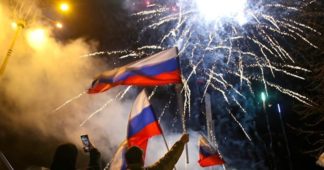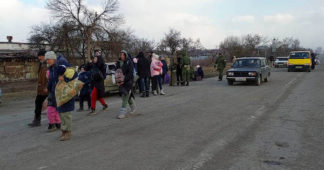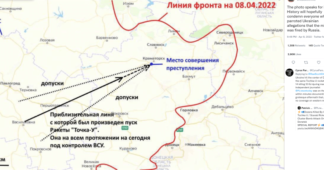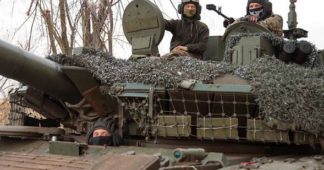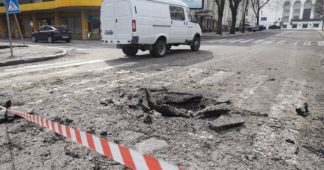The battle for Ugledar, as well as the earlier battles for the cities of Bakhmut, Avdeevka, and Mariupol, show just the opposite of the claims by Zelensky and his political/military government, namely that for the AFU, buildings and even ruins are more important than human beings in uniform.
By Dmitri Kovalevich
Oct 21, 2024
At the beginning of October, the development most discussed by the Ukraine government and its tightly controlled media was the defeat and withdrawal of the Armed Forces of Ukraine (AFU) from the small city of Ugledar (called ‘Vuhledar’ in Ukraine) in the Donbass region. The chaotic and costly withdrawal (for Ukraine) is the result of Kiev’s refusal to withdraw as the city was being encircled by Russian forces. This is not the first time this has happened.
Russian troops waited for evacuations of the remaining 116 civilians in Ugledar before entering and retaking the city on October 2. These were civilians who had been living in basements under shelling for the past two and a half years, refusing to be evacuated. The small city had a pre-war population of 14,000.
Ugledar is a former coal mining city some 50 km southwest of Donetsk city. Since being seized and occupied by far-right Ukrainian paramilitaries in 2014, it has been used by the AFU to regularly shell Donetsk city and neighboring cities and towns, causing countless civilian deaths, injuries, and property damage. Numerous towns and cities of the former Ukrainian provinces of Donetsk and Lugansk (which constitute the historic coal mining and steelmaking region of Donbass) were seized by the paramilitaries in 2014 and after, and have been used in this manner to terrorize the populations there. They resisted the illegal coup of 2014 in Kiev. Today, Donetsk and Lugansk are constituent republics of the Russian Federation, following several referendum votes that have taken place there.
The Russian army had attempted to storm Ugledar several times during the past two years, each time without success. The city is located on a hill and controls the surrounding steppes and towns for dozens of kilometers. Ukraine heavily fortified the city as part of its betrayal of the February 2015 Minsk 2 peace agreement it signed with Russia, which was sabotaged in the years following. Fortifications included those built underground in the extensive network of coal mine tunnels that date back some six decades.
From Ugledar, Ukrainian artillery could reach an important railway line connecting the now-Russian cities of Donetsk and Mariupol (on the Black Sea coast) with Crimea. One of the measures by Russian forces to protect the railroad has been to deploy a KingTrain in places along the route on one of the two railway tracks. The train consists of some 2,100 railroad cars of different types, altogether strung out over some 40 kilometers.
Ukrainian military analysts note that the Russian Armed Forces’ operation to capture this important, fortified area has given rise to a new tactic for opening up the echeloned (diagonal) defense lines of the AFU. It consists of first reducing such fortifications into rubble using bombs and artillery, then attacking with assault units from several directions, cutting through AFU positions along vectors converging on the center of the given fortified area and eventually bringing it under full control.
The 123rd Brigade of the AFU was sent from the city of Nikolaev (Mykolaiv), some 500 km to the west, to help those surrounded in Ugledar, but could not break through Russian defense lines.
On October 11, relatives of the surrounded troops staged a rally in Nikolaev, the capital city of the Nikolaev region, demanding that their sons and husbands be immediately withdrawn out of the hell the city had become. This was the second such rally in the city after authorities refused to act on a similar rally held four days earlier.
One week earlier, around 100 members of the 187th Battalion of the 123rd Brigade staged a protest (and here) in the small city of Voznesensk, located 100 km northwest of Nikolaev. They had left their military unit in faraway Donbass to draw attention to the insufficient training and lack of weapons of typical Ukrainian soldiers for combat operations.
Platoon commander Sergei told reporters at the rally he had repeatedly asked his command to at least add machine guns to the brigade’s arsenal but was refused.
Ukrainian conscript soldiers typically receive little training (one month, compared to the six months or more of a Russian soldier). Military units largely consist of working-class people seized off the streets, in accordance with the country’s draconian conscription laws. The criminal code of Ukraine stipulates that a serviceman has three days to reverse any decision to quit (desert) his unit. On the fourth day, the action is considered a criminal offense.
The Verkhovna Rada (legislature) of Ukraine is considering a bill that would exempt from criminal liability the servicemen who desert their posts but then voluntarily return to duty. Rada deputy Fedir Venislavsky told TSN.ua news agency on October 2, “The current law works, but only applies to a soldier who has been formally notified and charged with desertion and a court decides to exonerate him. We want to avoid criminal proceedings altogether against a soldier who voluntarily returns to his unit.”
Ukrainian analysts discuss the fall of Ugledar
Ukrainian military journalist Volodymyr Boyko blames the fall of Ugledar on increased desertions from AFU ranks. He believes that this has already led to the loss of dozens of other settlements. According to him, half of his own military unit deserted over the course of August and September of 2024. He says he had earlier warned his superiors of a threatened, chaotic retreat of the remnants of the 72nd Brigade from Ugledar if there was no order forthcoming from higher up the chain of command for an orderly withdrawal.
Boyko also predicts that more and worse can be expected along the entire front line of the AFU in Donetsk due to the poor quality of replacement troops, comprised in large part of recent recruits. In his opinion, the collapse of the army has reached such a scale that no measures, such as changing of commanders will help, as in his view, there are simply not enough personnel to hold the front lines. He gives an example, saying that out of 50 recruits sent to strengthen the defense of Ugledar, only four ended up in defense positions, and even they deserted during their first rotation out of the front lines.
He believes the draft law to ease the punishment of deserters will not help the military effort. “Since the deserters will be considered returned to military service, an illusion of the combat readiness of military units will be created on paper. As for the consequences of this madness, they are obvious: in October-November, several tens of thousands of soldiers can be expected to desert from the front. The next city to be targeted by Russia will become Pavlograd.”
Pavlograd is a vital rail and industrial city located nearly 200 km west of Ugledar, with a population of 100,000. It is located a mere 40 km east of Dnipro, the fourth largest city in Ukraine.
Assessing Boyko’s statements, Ukrainian legislator Olexander Dubinsky believes that the AFU is on the verge of disaster due to desertions. “Boyko writes that the rate of desertion from the army is reaching 15,000 people per month. This is roughly the rate of monthly conscription recruits. If this is true, it is a disaster,” the Rada member says.
Dubinsky also notes that many Ukrainian recruits do not live long on the battlefield, “I have gathered and examined the terrible math of war, relying on reports in the media, primarily foreign media, and also on postings to social media by military members. The average duration of survival of a new recruit on the front lines is two to three months. To be more precise, one month is served in ‘boot camp’ (training), and then up to two months serving somewhere on the front lines. After that, 70 per cent of these recruits end up killed or wounded.
“The ‘law of old men’ is well known ever since the first world war, and this is how it works: When receiving new recruits, a commander puts them in the most dangerous areas in order to save experienced soldiers and those whom he knows personally,” he wrote.
On October 3, Zelensky blatantly lied to the Ukrainian population by saying that he gave an order to withdraw from Ugledar because “people are more important than buildings”. However, Ukrainian military officers and soldiers claim they received no orders to withdraw. Many of those able to do so ran away chaotically on their own.
The battle for Ugledar, as well as the earlier battles for the cities of Bakhmut, Avdeevka, and Mariupol, show just the opposite of the claims by Zelensky and his political/military government, namely that for the AFU, buildings and even ruins are more important than human beings in uniform. The loss of a square kilometer of ruins is negatively perceived by Western sponsors, while information about human losses is treated as “classified information” and withheld from the Ukrainian people and from the people of the world.
Zelensky would never order a withdrawal from the Right Bank (western bank of the Dnieper River, which divides Ukraine in two) of the Kherson region as did Russian commanders in November 2022. They cited a high risk of heavy personnel losses due to logistical (transport) difficulties and their wish to prevent heavy damage to the city’s buildings and physical infrastructure.
Eyewitnesses to the loss of Ugledar
Two soldiers of the 72nd Brigade of the AFU who survived the collapse in Ugledar were interviewed by the BBC for a story published on October 2. They said they withdrew from the city without waiting for an order to retreat because defense lines had become completely disorganized and communication was lost. “Without an organized withdrawal, the situation became chaotic,” said a machine gunner named Roman. “You either die or retreat.”
Further, writes the BBC, the withdrawal itself was “close to a suicide mission”, particularly in daylight hours.”I don’t know why [they didn’t give the order],” machine gunner Roman said angrily. “Maybe it is fear of personal consequences of an evacuation order at the hands of the military leadership, or maybe it was an order from the top to hold positions with our blood until the very end.”
During the entire Russian special military operation, Ukrainian soldiers have never received an order to withdraw or retreat, even from the worst positions, such as encirclement or when holding onto ruins. This contrasts with the record of Russian military units, which constantly maneuver, advancing one day, retreating the next, and then advancing again.
Nikolai Voroshnov, an aerial scout of the 72nd Brigade (AFU), confirms that they did not receive an order to withdraw from Ugledar, notwithstanding Zelensky’s claims to the contrary. “Ugledar was doomed, it was impossible to save it. However, the soldiers there could be saved. However, the order to withdraw was never given. Everyone in the city and around it understood that the deadline for Russia to take the city was counting down in days, and then in hours, but the order to withdraw was not received,” he said, voicing his indignation.
Another serviceman from the same 72nd Brigade, Viktor, who served at the headquarters of one of the brigade’s battalions, told Slidstvo.info (as cited by Strana.ua) that he had only one platoon left, and out of 350 men, only some 30 were still standing. During two years of fighting, he said, the platoon was down to nearly zero; the replenishments that were sent were typically called ‘grandfathers’, meaning they were over 50 years old and poorly trained.
He says his unit was expected not so long ago to join a ‘counteroffensive’, but there were few men left to hold their positions, leave alone to advance and take new positions.
Strana wrote further, “When asked why it was not possible to hold the city, which stood on a rise, had a very favorable position for defense and which his brigade and other units had held for two years, Viktor answered as follows: ‘What is the value of holding a dominant height if enemy drones hang over you 24 hours a day? The enemy had an advantage in artillery, while we practically had none. It was not like it was in the winter of 2023. Also, Russian units began to remotely mine all access roads to the front. Yes, their infantry are bums, but they have an advantage in weaponry and in quantity. We simply had no one and nothing to fight with.”
Ukrainian nationalist and journalist Yuriy Butusov claims that there was no order to retreat because of Zelensky’s public relations machine, the cost of which is paid in the lives of soldiers. The ‘public relations’ refusal (to order a withdrawal from Ugledar) is an ‘ostrich’ policy, in which orders that would negatively affect the ratings of Zelensky’s ‘Servant of the People’ [the name of Zelensky’s electoral political machine] are not taken. “Volodymyr Zelensky deliberately hinders the correct, necessary tactical decisions in the war, and because of this irresponsibility, many people die, as happened, unfortunately, during the withdrawal from Ugledar”, wrote Butusov.
Ukrainian political analyst Andriy Zolotaryov said in a published interview (as reported by Politnavigator.ua on October 2) that the withdrawal order was not given so that Zelensky could claim during his visit to the United States at the end of September that Ugledar was still holding on. The result, says Zolotaryov, will be an increase in demoralization of Ukraine’s soldiers and population.
“So far, we can only guess what the price of this retreat was and will be. Everything could have been done with much less blood, but it was important to show that the president of Ukraine is in the United States, Ugledar is still holding on, and so on. But at what cost? This is another example of political necessity prevailing over military expediency. The demoralizing effect of all this could be very serious,” the analyst predicts.
In a truly independent state, military leaders such as those on display in Ukraine would face court martials for their reckless squandering of human resources. However, Ukraine is a proxy force for NATO, and Ukrainians are merely expendable pawns in the West’s grand game of maintaining its global hegemony, whatever the human and societal costs
We remind our readers that publication of articles on our site does not mean that we agree with what is written. Our policy is to publish anything which we consider of interest, so as to assist our readers in forming their opinions. Sometimes we even publish articles with which we totally disagree, since we believe it is important for our readers to be informed on as wide a spectrum of views as possible.

